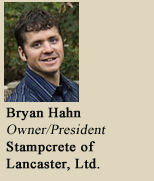 | |
featuring
Lancaster County Home Improvement Professionals
R&A Magazine: Ask
the Experts » Outdoor : Landscaping/Lighting/Spas/Pools/Decks/Outdoor Kitchens
|
||
| [ Click each Question for the Answer ] | ||
|
Are the winter months too early to start planning my ideas for a backyard makeover with an outdoor living company?
Answer provided by: Marketing Team at www.EWBN.net
Planning your outdoor living projects during the winter months is a strategic choice that offers numerous advantages. While many people associate outdoor improvements with warmer weather, starting the planning process in the off-season can set you up for success when spring and summer arrive. One of the primary benefits of winter planning is the ability to get ahead of the crowd. Outdoor living companies often experience a surge in demand during the spring and summer months. By starting the process during the winter, you can secure a spot on their schedule and avoid long wait times. This head start ensures that your patio, deck, outdoor kitchen, or fire pit is ready to use when the warm weather rolls around, allowing you to make the most of the outdoor season. Winter also provides ample time for thoughtful design and decision-making. With fewer distractions and a slower pace, you can collaborate closely with the design team to refine your vision. Whether you’re dreaming of a cozy fire pit for family gatherings or a fully equipped outdoor kitchen for entertaining, the extra time allows for careful planning and customization, to make every detail just right. The winter season also provides a unique opportunity to assess your outdoor space. Without the lush foliage of spring and summer, you can evaluate the layout, sunlight exposure, and drainage patterns of your yard more easily. This clearer perspective helps inform the design process, allowing your new outdoor features to work harmoniously with your existing landscape. At EWBN, we are eager to walk alongside you as you begin planning your dream space. Our team has the experience and care to handle any size project, and it is our goal to provide top-level service, while maintaining open communication throughout your project. The vision of our company is to “inspire creativity, validation, and appreciation to everyone in our sphere of influence.” If you would like to contact us this winter season to start dreaming about your backyard make over, please visit our website at ewbn.net or give us a call at 717-355-0741.
We recently bought a home that has a nice-sized backyard but, unfortunately, doesn't have any amenities such as a patio or deck. Our preference is to have a deck installed but we're not quite sure how to proceed. Any suggestions?
Answer provided by: Ray Ebersol, Manager Decks R Us LLC
If you’re looking to transform your outdoor living space with a beautiful, durable deck, Decks R Us has got you covered. No matter what you’re looking for in a deck, we are committed to making your deck dreams a reality. We strive to make the deck-building process as easy as possible for our customers. From coming up with an estimate to helping you choose the right design and materials, we will communicate with you every step of the way. There’s a lot to take into account when planning your new deck. Below are some things to consider before getting started. Knowing the answers to these questions ahead of time will make the deck-building process go more smoothly for you—and us! How Will Your Deck Be Used? After giving us a general idea of how you plan on using your deck, we’ll help determine what size, shape, and style of deck will be best for you. What Features Do You Need?
Stand Out or Blend In?
Materials to Consider
Ready to Get Started with Your New Deck? During the consultation, we’ll ask you some questions to find out what you’re looking for in a deck and take a look at your space. Once we examine your land and take a few measurements, we’ll begin going over the different choices you have when it comes to building your deck. We’ll gather a sense of your budget, and then come up with a ballpark price of what your deck may cost. To request your free consultation, or for more information about our services, give us a call or send us an email. We look forward to working with you and helping you build your dream deck!
How can I build a dream garden, without bending over backwards to maintain it?
Answer provided by: Ian Hanselman, Marketing Manager, Hanselman Landscape
& Gardens
Minimizing garden maintenance is a common priority for many clients. Hanselman Landscape & Gardens designs, installs, and cultivates lowmaintenance gardens using several strategies. Choose plants carefully. Use nature skillfully. Enlist the help of experts. To learn more about how Hanselman Landscape & Gardens can help you build your dream low-maintenance garden, please visit our low maintenance garden page: https://www.hanselmanlandscape.com/design/low-maintenance-gardens/ If you are interested in exploring our other garden design specialties, including Japanese gardens, Natural gardens, and Courtyard gardens, or if youare looking to incorporate exquisite garden elements like natural stone and boulders or well-developed specialty plants, please visit our website to learn more. Better yet, give us a call and we'll set up a time for a no obligation consultation.
When we bought our home six years ago, our two-car garage was a great luxury. Back then, we parked both cars in it. Over the years, however, due to the growth of “stuff” such as lawn mowers, a snow blower, yard tools, bicycles and pool equipment, finding space to park has become a real challenge. Short of expanding our garage, what can you recommend that will be affordable and enhance our home?
Answer provided by: Jeannie Kontis
, Owner, Fox Country Sheds
I would like to order a storage shed to match my home, but I am terrible at visualizing so many choices. How can I know what a custom shed will actually look like before hand?
Answer provided by: Jeannie Kontis
, Owner, Fox Country Sheds
With an outdoor kitchen project in our plans, what can you tell us about the different types of grills—charcoal, gas, wood-fired and pellets—and the pros and cons of each?
Answer provided by: Sam Jay Stoltzfus, Owner, LanChester Grill & Hearth, LLC
CHARCOAL GRILLSFor the very best grilling in charcoal, I would recommend a lump charcoal over a briquette charcoal. The pros to a lump charcoal such as used in the Big Green Egg are 1) the control you have over the heat. You can slow cook at 180 degrees or sear at 700 degrees if you wish. 2) The flavor of the food from the lump charcoal grill is hard to beat! 3) The versatility of the grill. While it may take a bit more effort to fire up the Big Green, I will fire up my Egg just to grill six hamburgers rather than use my gas grill. This charcoal grill can cook almost anything and not dry out the food. The cons for the Egg are the limited cooking size and a little more work to start it. Other than that, it is one of my favorites. GAS GRILLSThe pros of a gas grill are: They are very convenient and easy to use. The temperature is controlled with the turn of a knob, anybody can use them, and there's very little clean up. They can have an infrared burner for sear- ing. Sweet corn on a sear burner is the fastest way and best tasting way to prepare sweet corn—it only takes a few minutes and will give you the juiciest sweet corn. Some gas grills even have temperature controls. One of the cons of a gas grill is the need for a gas source and it tends to dry food out a little if not careful. WOOD-FIRED GRILLSWood-fired grills like the Hancock grill are the most fun wood-fired grill to use if you are cooking for larger crowds. If you love to cook on a griddle, this is a great grill to use! The cons would be the length of time it takes to get the grill hot. WOOD PELLET GRILLSFor wood pellet grills, the Memphis wood-fired grill is my all-time favorite with the touch screen controls and insulated hood. You set the temperature desired, and it will keep it right there until you adjust it. There are various fla- vors of pellets to use for smoking, this is probably the easiest way to smoke and bake on a grill. I have smoked brisket, ham, loins, and many other foods. I have baked bread, cookies, brownies, and more on this grill. It is also great for pizzas and steaks! I really don’t have any cons for the Memphis pellet grill. No matter what route you go with, know that the professionals at LanChester Grill & Hearth are here to help you. In addition to grilling, we also have a pas- sion for assisting homeowners with outdoor kitchen designs and products. Let us help you upgrade your grilling and outdoor kitchen experience today!
We have a very nice patio area that is almost unusable in the summer due to the heat and other weather conditions. We currently use an umbrella but what are some other ways to make this area more useful without breaking the bank?
Answer provided by: Les Kreider, President-Owner, Kreider’s Canvas Service, Inc.
One is a retractable awning which advertises âsun when you want itâshade when you need itâ! However, there is an unmentioned variable which controls that choice. WIND! The wind limits when you are able to use a retractable awning. Ten to fifteen mph winds with occasional wind gusts are often too much wind to safely use an extended (open) retractable awning. Your type of awning choice also effects your type of furniture you can use because a retractable awning spends most of its life rolled up along a house while not providing rain or sun protection for you or your furniture. Additionally retractable awnings offer no protection from morning dews as we have heard from folks wanting to enjoy breakfast on their patio. A second less advertised option is a stationary-framed canopy where the cover is seasonally reinstalled in late spring and removed prior to fall or winter snows. With a stationary type of awning there is rain and sun protection all summer long while the cover is in place and, when properly fitted, winds will have no effect. Properly installed and constructed, this style of awning will lower patio surface temperature over 50 degrees as I have personally observed on numerous occasions. One 87° day produced a 139° surface temperature in the sun which lowered to 87° when the area was covered with the awning. This cooling effect happens every sunny day, even if it is windy. A retractable awning can’t do this because it can’t be extended in wind, especially when there are wind gusts. Retractable awnings have additional shade challenges especially when used in the late afternoon (3 PM till sunset) as they have no side wings to block the sun. On the positive side, once they are installedâthey are installed. In addition, they are easy to close or open provided they have a motor and electricity. Just a button to push. Stationary covers, on the other hand, should be taken down each winter season to preserve their beauty and extend their life. As for how much time it takes for the annual ritual of installation and removal, I have experienced a 14’x16’ stationary cover installed by one person in around 45 minutes in the Spring and around 25 minutes in the Fall for removal of the cover. For that 1.5 hour of work per year a stationary frame cover will provide over 3600 hours of protection for furniture and extra entertaining space even in the sun, rain, and wind. We have found that time well spent because when the cover is removed, the winter sun is able to flood a home with welcomed interior light and warmth. Of the three lower-costing protection options for your patioâan umbrella, a retractable awning, or a stationary framed canopyâeach has advantages depending on how much you intend to use your patio. If your objective is to maximize its use regardless of what mother nature has in mind, a stationary canopy will be your best option. For more information, give us a call or visit us online. With our 40 years in operation and 135 years of combined experience within our team, we'd be happy to help you.
What are some of the elements that provide seasonal interest in your
garden and the gardens you build for others, even in winter? What
steps do you take to ensure beauty in a winter garden?
Answer provided by: Betty Hanselman
, partner, Hanselman Landscape
& Gardens
In winter, there are more incremental variations from moisture and temperature with which our gardens interact. Consider the varying moisture levels affecting the color and feel of natural stone. On sunny dry days, a hand-cut, Japanese-inspired stone walk or patio evokes bare-footed warmth as eyes wander outside. On other days, the dark moist boulders wear a cap of white or become part of a larger drift of snow, combining with the hand-shaped azaleas behind them, reminiscent of drifting dunes but imbued with the form our gardens develop from our years of nurture. At times these atmospheric effects emphasize fine detail, such as when twigs and buds of our Japanese maple trees are delicately outlined with a light snow. After grooming black Pines, each needle is a fine green line, topped with icy crystals against a background of cerulean or white. On wet days, a tree’s bark is darkened, each year showing more layers and intricacy. At times, ice forms on each twig, exposing the beauty and strength of the entire sculpture. And until extreme cold forces a deeper dormancy, lawns are a brilliant green carpet. Likes waves advancing and retreating, the garden is sometimes more exposed and then buried gently or deeply by snow; the intervals between objects in which you see and experience the garden become more apparent. Practically speaking, we seek to bring all-season beauty to a home’s surroundings in the following ways: ⢠Careful planning during the garden’s design phase So that structural interest is always apparentâeven in winter, when many garden colors have disappearedâwe incorporate large boulders, natural stone paths and patios, and plants with varied barks, branching structures (Japanese Maples, for example), and berries. We also include plenty of evergreen shrubs and trees (Hollies, Azaleas, Laurels, Firs, Cryptomeria, Pines and Cedars, to name a few) to provide diverse textures and shades of green against the winter whites and browns. In addition to the interest that evergreens bring to a winter garden, they are beneficial in that they provide vibrant privacy screening around a property and a haven for bird life when other plant hideouts are bare. ⢠Careful pruning and plant care throughout the year By maintaining plant structure during regularly-scheduled service visits, and by treating disease and pest issues if and when they occur during the warmer seasons, we are able to enhance the all-season beauty and health of the gardens in our care. (Note: Specific to winter garden care, we offer an anti-desiccant spray service to minimize the effects of freezing temperatures, such as winter burn, on evergreen plants.) We invite you to enjoy the many delights of winter by enhancing your garden view. We offer many interesting structural and organic elements and plant care measures so that you can indeed experience all-season joy in the garden spaces around your home. For more information, please visit our website and give us a call when you're ready!
We have an attractive home with a two-bay garage. When we first moved in,
I used to describe it as a two-car garage, but now we can barely squeeze in one car. Depending on its ap-pearance (we are extremely fussy about the looks of our property) we are looking at sheds as an alternative to cluttering up our garage space. What are some of the popular upper-end cosmetic options/considerations available to us in designing a custom shed?
Answer provided by: Jeannie Kontis
, Owner, Fox Country Sheds
Adding storage and value to your home can be easier than you think, especially with the options available to you today. Today’s backyard storage sheds are more than âjust a shedâ and are avail-able in a variety of attractive and current styles to complement your home’s exterior aesthetic. Con-sider selecting a maintenance-free vinyl siding exterior in a variety of colors, to start with. Or, perhaps decide upon a warm-toned painted wood siding for a timeless appear-ance. Once you have a main color scheme selected, you can choose from a broad variety of trim colors as an accentâselecting a palette that would closely match your home or complement it in other ways. Add an attractive overhead garage door for easy access to your riding mower in a color and style to match your trim or current garage doors. If your home has a stone veneer accent exterior, there are options available to complement this fea-ture and create a coordinated look. Options such as a stacked stone or brick in a maintenance-free siding product proves popular amongst the homeowners who are looking to complement their home’s stone features. Topping off the shed, a current trend is upgrading to a metal roof for a timeless upscale appearance. A metal roof is standard on some of the more upscale shed styles, and is available as an option on almost any other shed. Or, if you prefer to better match your home with shingles, quality architectural shingles (also known as dimen-sional shingles) is a standard building spec available in a variety of popular colors. The cherry on top would be adding a maintenance-free cupola built with an Azek base and a shiny copper or aluminum top. Adding a weathervane that shows off your favorite hobby, such as a swinging golfer or perhaps a whimsical mermaid, can add an elegant and yet personalized touch to your new attractive outbuilding. No matter the size of your new shed, whether you need a larger prefabricated garage with an overhead door (go ahead and add that garage door opener, no problem), or a smaller garden shed to house your lawn tools (add lots of windows to start your veggie seeds), today’s backyard sheds can easily be an attractive and valuable addition to your lovely home and property. For more information, please visit us or give us a call. We encourage our customers to visit our display lot to get ideas of what other customers are having built. Let us help you!
Like most, we stayed at
home more than normal last
summer due primarily to
Covid. With so much time at
home, we quickly realized
how unusable our patio area
was much of the time because
of excessive heat. How
can we make this space more
usable this coming summer?
Answer provided by: Les Kreider
, President-Owner, Kreider's Canvas Service, Inc.
Often dark surfaces are warmer than light surfaces. One interesting fact that I discovered several years ago on a medium dark surfaced deck was the extreme heat gain. It was around noon on a 87 degree day. I checked a shaded area’s temperature with a digital thermometer and it was 87 degrees, Next, I aimed the thermometer at a sunny area and it measured 139 degrees. Yes, that was 52 degrees warmer than the air temperature! Solar gain at its best...or worst if you are sitting in this sunny area or walking on this sunny area. That is 52 degrees warmer than the air temperature. Small wonder that any shade from an umbrella or awning feels so much more comfortable. Last summer many people discovered the importance of additional shade which allowed them to use their deck or patio areas safely while socially distancing. This additional space provides outside protected space at a more reasonable cost than adding a roof or addition. A roof or addition remains in place all year long, whereas an awning or canopy has the cover easily removed which allows the sun to work its magic on interior rooms. In other words, you can have your cake and still eat it. Solar shade in the summer and winter solar gain thru windowed areas adding free heat and light to your home’s interior. If properly done, a tight-fitting awning or canopy will withstand all of summer’s storms. In summary, a canopy or awning will provide you with a cost effective and reasonable solution for your patio area. Last summer we turned many useless areas into enjoyable and safe areas. Outdoors was the way to stay safe while still being more comfortable. Even the CDC recognizes this. This gives you another option for a better way to socialize and enjoy family and friends during the summer. For more information, please don't hesitate to give us a call or visit us online. As I like to remind folksâ "summer is too short to have a patio that you can't use comfortably!"
We are realizing the value of beautiful home surroundings
and are considering a major landscape
project. How can we avoid the waste of money and
lost years of opportunity when unattractive plantings
need to be thrown out and replaced? Can we
ensure that our garden investment will grow in
beauty and value as the years pass?
Answer provided by: Betty Hanselman
, Partner, Hanselman Landscape
& Gardens
Appropriate garden care requires knowledge of plant growth habits and responses to pruning. The best gardeners take time to learn about their plants and how to enable each one to play its role with excellence. Plants are not inanimate objects to be shaped or âfinishedâ in a single session. Rather, successful pruners have learned the secrets of training their valuable plants over time, to thrive together in a graceful, cultured setting. Appropriate garden care requires skilled, experienced eyes and hands to see the potential and then develop the garden into a living âpaintingâ, using the best plant- care techniques. The prime commandment is âFirst, do no harm!â Too often, unskilled cutting results in hacked-off branches and over-sheared hedges with dead or dying interiors. An experienced, caring pruner will provide timely guidance for the plants in his or her care, allowing the plants to reach their potential within the spatial constraints of each unique place. Appropriate garden care takes effort, not just to accomplish the regular tasks of planting, pruning, and shaping, but also to keep on caring. When the desire to care wanes, achieving a well-loved garden is almost impossible. A garden care team will help you keep your dream alive!! Hanselman Landscape specializes in nurturing gardens. We would be honored to partner with you to realize a garden you will cherish now and into the future.
We’re in the market for a
shed, but not interested in
a cookie-cutter model like
those you see pretty much
everywhere. Instead, we’re
looking for a specific look as
well as one that will serve
specific functions. Short
of engaging an architect to
design a custom shed specific
to our wants and needs, what
can you recommend?
Answer provided by: Jeannie Kontis
, Owner, Fox Country Sheds
Some of the way we can do this is to help you select one of the many styles of sheds that we offer. Using one of these styles as a template, we can add windows or doors to really customize the layout that works best for you. Perhaps you want an overhead door so that you can drive your riding mower right inside. Or add a row of windows and a workbench so that you can have some natural light to start your seedlings early. We can even create a poolhouse look to add an attractive storage or changing area beside your new pool. Selecting your roof shingle color, topping off with a cupola or weathervane, or adding an attractive metal roof are other ways to really make your backyard structure stand apart from the rest. As for the exterior, we offer a variety of vinyl siding colors so that our customers can best match or complement their home. If you have a specific siding in mind, it’s not a problem for us to special order it. We also offer a durable and attractive wood siding that can be painted from a selection of attractive exterior paint colors that we offer. In keeping up with modern design trends, our experienced salespeople can help you design the âModern Farmhouseâ look, as well as a private âShe-Shedâ or âMan Caveâ. Customers are encouraged to share their design ideas with us. For enhanced quality, all of our structures are prebuilt in our climatecontrolled manufacturing shop, and as owners of this 22-year family business, we take pride in being hands-on...from start to finish! Remember, customizing your backyard shed, poolhouse or mancave/ she-shed, is a foolproof way to add instant value to your home. For more information, please visit us or give us a call. We encourage our customers to visit our display lot to get ideas of what other customers are having built. Let us help you!
As garden builders, you and James seek to cultivate daily interaction
with natural beauty for your family and clients through the creation of
private garden spaces. Now, with the recent Covid-19 shelter-in-place
restrictions, have you sensed a greater appreciation for these personal
garden spaces?
Answer provided by: Betty Hanselman
, Partner, Hanselman Landscape
& Gardens
When I am rattled by strident media opinions, I can pause for just a moment on the stone steps in our garden and observe the painstaking progress of a spider repairing its web between two branches of a Japanese Maple. I can listen to the whisper of the wind through the Pines above me or watch tiny leaf buds unfurl in the spring sunshine. Our garden is a sanctuary where I am able to slow down, breathe deeply, and regain my balance. It is my daily vacation, and since right now, it is our only âlet’s eat outâ option, we are privileged to dine under the sky and trees, accompanied by the whirr of hummingbird wings and bird song. When I am disheartened by the cares of the world, I only have to look up at the Cardinal singing its heart out in the branches of a Dawn Redwood to remember that I, too, have a myriad of reasons to rejoice. In my garden, I am reminded that the Almighty Hand that clothes the flowers and feeds the birds also cares for me. My garden becomes a cathedral where my heart cries out for wisdom and shouts out songs of gratitude and praise. Our garden is a shelter from the chaos of conflicting headlines. It is a place where, with careful tending, growth is measured and certain. There is hope in our gardenâthat spring will surely follow winter; that what was green and vibrant last year will burst forth in color, fragrance, and beauty once again; that someday soon, we will again hear delighted little voices exclaiming over wildflowers and âunder-doggiesâ on the swing; that the cares of today are just for a moment and will eventually recede in memory. I need a garden in my life because I need rest and shelter and joy and hope . . . especially now! Hanselman Landscape is a family-owned business established in 1985. Believing the world can be beautiful, we are dedicated to bringing natural beauty within the daily reach of our clients. With unique solutions to complex challenges, Hanselman Landscape’s garden design experts will embrace your home with a custom-tailored, sustainable landscape design. Japanese gardens, swimming pool landscapes with refreshing waterfalls, and carefullypruned specialty plants are just a few of the ways we can bring natural beauty into your daily experience. We prioritize long-term relationships, which allows our customers to develop the high quality gardens they desire. And if it’s ongoing care you desire, you can enjoy a lifetime of support through our skilled maintenance program. In fact, we continue to serve our very first clients! Our location in Manheim provides us with access to design and cultivate gardens throughout Central PA, Philadelphia’s Main Line, and even as far away as Cambridge, Massachusetts. We invite you to explore how we can partner with you to bring joy to your garden!
We're planning to do some
patio renovations this year
that will include an outdoor stone fireplace. Do
we need to wait for spring
weather or can masonry
work be done safely in
cold weather?
Answer provided by: Terry Heck
, Owner, Raise The Standard, Inc
The facts don’t change however, as 32 degrees has always been, and will always be, the point at which things freeze. It could be an ice cube, popsicle, or the mortar between two bricks. What ever it may be, if it has some type of fluid in it, those particles will freeze when temps hit 32. Since most masonry companies need to work through the winter to pay bills and keep their employees working, here at Raise The Standard, we've come up with some simple solutions to keep working through colder temperatures without compromising the quality of our work or our finished product. Different companies have various methods that they have found that works for them. Below are a few things we do on virtually every job we touch in the winter months to keep our work safe, looking great, and hold up for years to come. First and foremost, we keep the moisture out of the products to be installed by covering them with plastic or special blankets made especially for our industry. Secondly, we heat the sand and water with propane torches. Finally, when the day is complete, we cover our work with those special blankets which help to store the heat produced from the hot water plus they keep the cold weather and wind off the masonry. So, to answer your question, no, you don't have to wait for warmer weather to get started on your project. While we do work year round sometimes it just gets too cold and miserable and we have no other choice but to work inside (or forced to stay home and enjoy a cup of hot chocolate). In addition to inside projects such as fireplaces or stone or brick accent walls, periods of very cold weather is a perfect time for us to get our preseason planning accomplished and lining up new projects in our pipeline schedule. Should you have questions about any type of masonry work or would like to get your project scheduled, please reach out to me. No question or problem is too big or dumb.
We are into the season where we want to make better use of our deck area especially when we have extra guests visiting. What are some of our options?
Answer provided by: Les Kreider, President–Owner, Kreider's Canvas Service, Inc.
1). The lowest cost improvement is an umbrella. Wind and limited spotty protection are an umbrella's challenges. Sudden wind gusts can be damaging both to an umbrella, table, and a house as they are like kites waiting to fly away. 2). The next improvement is a retractable awning. This also has challenges with wind and limited shade in the mid to late afternoon. Often this is when guests are invited for a meal. Retractable awnings provide better protection than an umbrella but are more expensive. They can provide shade and limited protection only if there are very low winds. There are times it may be too windy to use a retractable awning even if it has a motion sensor, so you may end up sitting in the sun with no shade. Additionally these motion sensors have limits and can be challenged by sudden wind gusts. 3). A third improvement for extra deck usage while providing shade and rain protection is a stationary frame canopy. The challenges are that a loose fitting cover or a weak frame design can collapse the frame or cause other damage in a strong summer storm. This method is where only the synthetic cover is folded up and removed over winter. The frame stays in place but may be powder coated a black or bronze color to make it less visible. Dark colors hide from view to our brain and seem less noticeable. This winter cover removal allows winter sun into any adjoining rooms around the deck which can raise room temperatures 10 to 15 degrees above normal room temperatures. This can make a noticeable savings in heating in winter and cooling in summer. Several university studies have documented up to a 30% energy savings when removable awnings are used. The canopy cover is then reinstalled in the spring providing shade to the house while providing additional outside deck area for entertaining. The deck surface temperatures on a sunny day are often reduced over 50 degrees on the deck's surface making the walking area useful again. If the canopy cover is tightly fitted onto a strong frame, wind isn't a challenge with this type of solution. Around October, the easy to remove cover needs to be removed due to the coming winter snows. Additionally side curtains and triangular ends (often called wings) give extra shade as the sun sets in the late afternoon. These are considered temporary structures so no permits or approvals are often needed because snow loads aren't required. The stationary frame's cover is removed over winter so there is no snow build up needing supported. Most people like the annual canvas installation ritual as they often open a pool (if they have one) and bring their furniture out of storage for the celebration of summer's return. 4). A roof can be added to some decks to provide extra coverage and protection. This is usually the most expensive method to get extra protection from the sun because the roof and especially the footers of the deck need to meet engineering requirements for winter snow loads. Most existing decks don't meet current footer engineering requirements so a major cost is incurred in replacing the existing deck in a way so it will support snow load requirements to hold the roof in place. With this improvement method you usually get a long lasting product, but you often lose the solar benefits in winter. Some people take this approach anticipating a future improvement of closing in the area to a three season room. This roof method does provide a year round covered area for storage. Additionally still other people also enclose the sides with canvas /vinyl window curtains that provide wind /heat protection. This side curtain addition also provides them with the ability to roll the sides up and get the full outdoor effect of a covered open area. Of the four main methods to get additional shade and protection for a deck area, each has limits and benefits as well as varying costs. Each situation is different and it isn't a one-solutionfits-all approach due to wind patterns and sun exposure. Loss of sunlight also becomes a factor especially in the winter months. A lot has to be considered before rushing to any one solution as a variety of factors need careful consideration. For more information, give us a call at 717.656.7387.
A while back, I remember seeing a Q&A in R&A that suggested a storage shed to relieve garage clutter. We too have garage clutter (lots of it) and a storage shed sounds like a practical solution for making room for our two cars. My concern is selecting a shed that is well constructed with quality materials AND one that actually complements our attractive home and landscaping. We are very discriminating shoppers. Any suggestions?
Answer provided by: Jeannie Kontis, Owner Fox Country Sheds
One of the main considerations in selecting a storage shed is to consider exactly what your needs are. We can help you to determine exactly what you desire to store, and then discuss building materials and specifics. Are you looking to store a few handheld garden tools such as rakes, pruning shears and a push mower? Or are you looking for a larger structure to store a riding mower or tractor? Perhaps a motorcycle or bicycles, or even fun jet skis or snowmobiles? Are you looking for a structure to use as an "in-home office" or "mancave" or even a "she-shed"? If you plan on spending a lot of time in the structure, some of your selected building options might change such as insulated windows and insulating the walls and floor. The building specs used in all of our sheds start with the same quality materials, and the customer can upgrade certain options to meet their needs accordingly. Once you have determined what your structure will be used for and what size would work best for you, it is important to give equal attention to the foundation or "pad" where your shed will be placed. A great, well-prepared foundation truly is the first step in a quality storage shed, which should last you for as long as you own your home. We are happy to provide guidance for the handy homeowner who wishes to do the site preparation on their own, but our recommendation would be to not skimp on this step and to let our professionals take care of this important step for you. All of our sheds, no matter the size, are built with the same quality craftsmanship which we are known for, from the skids to the shingles. Pressure-treated lumber is used for all ground contact areas, what we refer to as "the runners". We go the extra step and use pressuretreated floor joists, as well. The interior plywood flooring can be easily upgraded to a pressure-treated material, and we can help you determine if this is something that would suit your needs. Selecting your exterior material is easy-the homeowner has a choice from a quality vinyl siding product, or a durable wooden siding material. Both have long-term warranties from their specific manufacturers. The vinyl siding comes in a number of popular colors, and the homeowner is sure to find one to match or complement their current home, or we can custom order a specific product for you. For the wood siding, we use an industryspecific "barn paint" which offers excellent coverage in a number of popular exterior colors. The discriminating homeowner who wants more than a shed may want to upgrade certain components, such as selecting our 9-lite steel door, or even a full-glass door option which would look great on a pool house or "sheshed". For extra insulation and security, we even offer a vinyl insulated window and pre-hung door option, exactly the same type you would install in your home. Last but not least, let's consider the shingles or roofing material of your shed. Our standard roofing material is a 30-year architectural shingle, which is certainly something that any discriminating homeowner would expect. We do also offer the option of a metal roof which is very popular for certain shed styles. Both roofing options are installed over a high-grade plywood sheathing and are available in a number of standard colors. Be sure to top off your new, quality-built shed, with an attractive cupola and weathervane, both available in a variety of options to suit your style. Our informative sales staff is always available to answer any questions you might have about the quality materials available for your new shed, garage or other backyard structure. Give us a call or stop in to see us!
If we are considering a renovation or addition that will add to our curb appeal, such as new exterior materials or a new front porch, how do you recommend we improve the front yard landscaping?
Answer provided by: Betty Hanselman, Partner, Hanselman Landscape & Gardens
As garden builders, we recommend improving your front yard landscaping by taking an additional step, considering an "inside-out approach" that prioritizes the perspective of the people resting, playing, studying, living in the home. What you see and experience when you look or step outside is also important. Rather than just planting a two-dimensional facade around the footprint of the house, our suggestion is to provide multi-sensory experiences in multi-dimensional outdoor living spaces-"garden rooms" which are seen from the windows, and where children of all ages can clamber or rest, listen to the sigh of wind in Pines, feel the variant textures of pathways and dewy grass underfoot, and smell the exhilarating fragrance of new leaves. This approach incorporates plantings and garden elements in ways that can be enjoyed and experienced by those in the home as well as those passing by. So, in addition to curb appeal, the view from those new windows should be considered. For example, a carefully-planned entrance garden will serve both objectives, adding depth and perspective to a home's curb appeal while providing interest for those who live inside. To have a garden that is experienced and enjoyed inside and outside the home evokes the feeling of being in a rare and special place for which curb appeal is only the first hint of discovery.
Over the years, R&A has published several very informative
articles and beautiful photos
submitted by Kreider Canvas
Service promoting their awning
and canopy business. While
the idea of expanding our patio
usage during rainy weather or
blistering sunshine through the
use of a canopy is very appealing, we just don't have the time
nor the energy to deal with the
annual requirement of putting
it up and taking it down. Is
there a solution?
Answer provided by: Les Kreider, President–Owner, Kreider's Canvas Service, Inc.
Now, in answer to your question, yes, there is a solution for busy homeowners like you. Here at Kreider's we offer full-service annual installation in the spring and takedown in the fall. And, if needed, we also provide worry-free winter storage. Here's how it works. Spring RehangSpring is a time to clean away the winter mess and get ready for outdoor living. When our trucks begin to move through the local neighborhood folks begin to get excited because they know warm weather is on the way. A patio covered by a Kreider’s canopy is a happy patio!! We take pride in providing you with top-notch service for your awning and or canopy. You will fnd us to be friendly, helpful and on-time. Awnings and canopies that we service are guaranteed to have a drum tight ft with as few wrinkles as possible. Awnings that are installed properly will last longer because they will not âpoolâ water or ï¬ap so much in the wind. Care will be given to avoid stepping on ï¬owers, railings or outdoor furniture. Our teams strive to leave your home looking better than when they came! Clients are encouraged to call as soon as possible to schedule their spring rehang. For the most effcient and worry-free service experience, ask to be added to the Auto list. We generally try to have the rehangs completed between April 15th and Memorial Day. Fall TakedownAs summer wraps up and kids go back to school and the leaves start to showcase their beauty our teams gear up for the fall takedown season. To give your awning the longest lifespan possible it should be taken down prior to any snow and ice accumulation. Typically when the days grow shorter and cooler you will be excited to have the extra light and warmth ï¬ooding in through your windows. An awning or canopy that is removed by Kreider’s will be carefully inspected for holes, tears or other issues that may need attention. Should you choose to have your awning stored by us, it will be tagged and warehoused within our clean, dry and rodent free storage facility. As with our rehangs, clients are encouraged to call as soon as possible to schedule their fall takedown. And, yes, like the rehang, we suggest that they get added to our Auto list. We generally try to have the bulk of takedowns completed with-in the month of October. So there you have it...professional and courteous help is readily available. Make the most out of your outdoor areas and realize some serious energy-savings in doing so by expanding and extending their usage. For more information on awnings and canopies, please give us a call or visit us online.
We are in desperate need of a suggestion that would allow us to keep our 3 little ones happy at home rather than packing them up to drive to the nearest park. The packing and unpacking not to mention the shuttle has gotten very old. Other than a swimming pool which is out of the question for now, what other backyard amenity would help keep the kids happy (and safe) at home?
Answer provided by: Jeannie Kontis, Owner, Fox Country Sheds
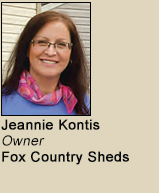
As a parent of two boys who are now grown, I certainly remember the days of trying to keep them busy at home, while making sure that they remain safe and within eyesight. At that time, I had invested in a rickety metal swingset that seemed to shake, rattle and rust with each swing and climb my boys made. I can honestly say that it probably wasn't the safest nor the most secure option, at that time. The backyard playsets of today have improved in many different ways. Safety is always a key factor, and all of the vinyl playset products which we carry follow strict safety protocol. You can indeed have peace of mind knowing that your playset manufacturer places priority on the highest quality materials and construction, as well as safety features. Some of the standard safety features of today's playsets which you should look for include: smooth, splinter-free vinyl coating and sleeves, entrance ladders with safety rails and nonslip steps, pinch-free rubber coated swing chains, heavy-duty hangers and fasteners, powder coated brackets to resist rust. One of the reasons that our playsets are so popular with families of all sizes is that you can customize them. The designs range from the simple 4x4 tower with a 2-position swing beam and a slide, to a complex multi-level and multi-tower design with numerous swing beams, assuring that each child of every age has a fun activity to explore. These playsets are built to last and are designed with fun options that can grow as your child grows. As your child grows, a baby swing can easily be swapped for one of the many big-kid swing options. You can easily arrange a variety of slides, twisty slides, towers and playhouses to maximize your child's outdoor excitement. What child wouldn't be happy playing on a set named the Giggle Junction? Children of all ages would enjoy swinging on the tire swing, or imagining that they are climbing Mount Everest as they ascend the rock wall. The Discovery Depot playset designs feature multiple towers of various levels, for those children who love to imagine they are world explorers. Playset packages come in a variety of sizes suitable to fit into smaller yards, as well as more elaborate designs for a sprawling backyard. No yard is too small for one of these quality, customizable playsets. Lastly, a concern we hear often is parents wondering just how long this type of investment will take them as their children and family grows. We are so proud of the Limited 20 Year Warranty offered by our playset manufacturer, Adventure World Gymsets. You can view more information about these quality backyard vinyl playsets, towers and playhouses, and even customize and order your own set, right on our website at www.FoxSheds.com. Of course, our helpful sales staff is always available to help you customize and design a playset to meet your budget and your family's needs. When we bought our home six years ago, our two–car garage was a
great luxury. Back then, we actually used both bays for parking. Over
the years, however, due to the growth of stuff such as lawn mowers,
a snow blower, yard tools, bicycles, yard toys, and an assortment of
odds and ends, finding space to park even one of the cars has become
a real challenge. Short of expanding our garage, what can you recommend?
Answer provided by: Jeannie Kontis, Owner, Fox Country Sheds 
I agree, a garage expansion probably wouldn't help—not for long any way. Chances are,
any additional garage space would be quickly consumed by even more stuff. A more promising
and less expensive solution may be a separate and dedicated storage building just
for your things. My suggestion would be to keep the garage for the cars (both of them) and
use your storage building for everything else. As for the aesthetics, you can specify wood or vinyl siding. Both options are available in the most popular residential colors to best complement your home. For a more custom look, some shed designs offer a stone-front option or have a mix of both vinyl siding and wood trim. A variety of roof shingles, window and door options––as well as accent pieces such as shutters, trim, flower boxes, cupolas and weather vanes––allow you to further customize your outbuilding to suit your taste and style. If all this sounds overwhelming, don't let it interfere with your decision to take control of your garage or storage needs. We can help you throughout the process. We are a family–owned business and we take great pride in helping our clients through the process of ordering, customizing, and delivering a product that will fulfill their needs while enhancing their property. Our sheds are delivered assembled via a shed trailer and placed right on your prepared site. We even have a crew that can prepare the site for you, or we can give you instructions on how to do it yourself. For property with limited access, we offer mule delivery or shed kits which can be assembled onsite. For more information please give us a call or stop by to see our display inventory. You can also visit us online at www.FoxSheds.com where you can customize and order your shed, garage, gazebo or playset. Either way, our friendly staff will be happy to assist you in solving your storage needs within a budget you can afford. Three years ago we had a beautiful deck installed off our kitchen/dining area. While the deck turned out absolutely gorgeous, I'm embarrassed to admit that we hardly ever use it. Why...you ask? It's the heat! With the intense sun on that side of the house, it's almost always too hot to use. We can't even enjoy the beauty of the deck from inside the house as we have to keep the curtains on the French doors closed to keep out the heat. This starts off in the spring and extends well into the fall months! Any suggestions?
Answer provided by: Les Kreider, President–Owner, Kreider's Canvas Service, Inc.  Your situation is not at all unique...in
fact, we addressed a similar problem
a few years back in this same column.
What we said then still applies today,
so here's a recap of our earlier response. Your situation is not at all unique...in
fact, we addressed a similar problem
a few years back in this same column.
What we said then still applies today,
so here's a recap of our earlier response.Too many, however, rush into a possible solution to a problem without considering all the options and the advantages each solution offers. Each "possible solution" also can have a negative side, which often isn't discovered until the installed "solution" is completed. Then it is too late or too expensive to change. We like to look at as many options that are available and provide honest "green" solutions. One of our favorite "green" solutions is a type of sun protection called an awning. The cover either rolls up or is removable for increased "over winter" solar gain. Some numbers that I have actually observed is a deck surface's temperature drop of over 50 degrees. That occurred on a deck where we were installing a stationary frame canvas cover over one half the total deck surface. It was an 87 degree (air temperature) day so I measured a hidden deck surface that hadn't been exposed to the summer sun. It measured 87 degrees. I then pointed my digital thermometer on a fully exposed deck area. It was about 11 AM and the temperature read 139 degrees. A 50+ degree difference. This is the same difference we experience when a canvas cover is installed over an exposed deck surface. The surface is now shaded and you are able to walk on it in bare feet. Try walking on a 139 degree surface! An additional "cooling effect" is experienced on interior rooms that are connected to these covered deck areas. A few years ago in the month of August, we installed another canvas awning over a west facing deck. Our customer thought it was a "sales pitch" when I stated that the attached interior family room's temperature will drop 15 to 20 degrees. To her surprise it really did!!!! Our customer found their air conditioner was now running less while keeping the family room cool. Less run time, less electric, and less energy used, lowering their overall summer electric bill. In fact, a study done by the University of Minnesota found that air conditioning costs could be lowered up to 30% with a properly installed awning. You have to remember that when the awning is removed over winter, the reverse effect happens. The greenhouse effect sets in and provides solar gain and heat to those areas previously cooled by a canvas awning. Talk about having your cake and eating it too! Awnings provide a tremendous green effect and energy savings. Proper installation of a correct type of awning, along with a good, durable fit is also important. A properly installed awning can be used for 12 to 14 years. We have had several last over 20 years. The synthetic fabric of choice is Sunbrella due to the fact that it now comes with a 10–year warranty. It is our preference due to its fade and "rot" resistance. There are other green and energy efficient solutions, but we have found an awning to provide a great option to environmental concerns. A proper choice of style and construction details is very critical to a long lasting solution. We analyze your area. We then make a recommendation based on our 80+ years of combined awning experience. We also manufacture (some styles), install, and service your awning needs. Our goal is to provide you with a durable and great solution to your energy problem area. We don't create another problem with a hasty solution. We aim to please and we give free estimates. Give us a call at 717.656.7387 for our solution suggestions to your problem area. We don't pressure a sale. We like to discuss your options for an area and provide you with a great solution. We recently visited Integrity Pools & Spas in Lancaster and noted that they only carry one brand of spas–Arctic Spas. Why is that and
what else can you tell us about Arctic Spas?
Answer provided by: Craig Horning, President, Integrity Pools & Spas, Inc.  At Integrity Pools & Spas, we support
Arctic Spas because of their
loyalty and their customer service to
their dealers. We are proud of the
craftsmanship of the product and
the serviceability and longevity of the
spas. Arctic Spas are a quality–made
hot tub and we stand behind them
with integrity. At Integrity Pools & Spas, we support
Arctic Spas because of their
loyalty and their customer service to
their dealers. We are proud of the
craftsmanship of the product and
the serviceability and longevity of the
spas. Arctic Spas are a quality–made
hot tub and we stand behind them
with integrity.From a consumer's point of view, here are some things that should be important for you to know about Arctic Spas. Energy–Efficiency. Arctic Spas insulate using perimeter insulation–they are not full–foam! They insulate the cabinet walls, lip underside and floors with a high density polyurethane foam. This foam is added to a thickness that stops heat loss. The equipment is then placed inside of this cocoon, creating the perfect environment to capture the heat from the pumps and motors. Ambient heat from the pump penetrates the spa shell and helps to keep the water hot. This allows for an extremely efficient design and dramatically reduces running costs. Heat rises, right? So another part of this equation is our Mylovac cover. This cover is 5", the thickest and strongest cover in the industry and reduces your electric cost by more than a 1/3 compared to the industry standard! Serviceability. All Arctic Spas come with insulated, removable access panels on all sides of the spa. Many spa manufacturers bury potential problems completely in foam. This makes servicing the spa very difficult when foam needs to be chipped out to perform the services and then more added after the service. Servicing an Arctic Spa is simple; remove a panel, perform the repair and replace the panel. Arctic Spas provides an easy and efficient way to deal serviceability. No Need for a Concrete Pad. All Arctic Spas that we sell come standard with the Forever Floor–which eliminates the need to construct a concrete pad. This floor is composed of SMC fiberglass composites that make it impervious to moisture, pests and time. It is the same material the U.S. Military uses on the bottom of their Hummers. It's so strong that it completely eliminates the need for a foundation such as concrete pads, decking or blocks! Installation has never been easier and your spa floor will last forever. Arctic Spas Shells–Legendary Strong! Roughly 98% of all spa manufacturers use acrylic to form the shells of their spas. The acrylic is formed into a seating pattern and then insulation is blown around the spa to give the spa strength. If repairs are needed, that insulation needs to be chipped out in order to find the location of the leak. ARCTIC SPAS vacform their shells and then apply layer after layer of a proprietary filler–free fiberglass composite material to give the shell its legendary strength. Arctic applies more fiberglass than anyone else in the business; no plastic backing, no props or supports, and no foam is ever applied to the shell. Ongoing Maintenance–Spa Boy Takes Out the Guesswork. Arctic Spas has a unique feature–Spa Boy– which is an automated, low chemical, saltwater sanitation water care system for your spa. Used in conjunction with an ORP probe; you can now monitor your water from your smart phone to ensure your water will be crystal clear every day from the comfort of your own home, or from anywhere in the world so long as you have an internet connection! We use science to perform the menial tasks that have generally been associated with spa maintenance. Finally, your Arctic Spa can be almost MAINTENANCE FREE! Take the guesswork out of spa maintenance with Spa Boy, only by Arctic Spas! In closing, let me just say that there's a reason why hot tubs are immensely popular at winter resorts all over the world. Put some fun in your winter– without leaving home! For more information please don't hesitate to give us a call at 393.1600. Or, if you are planning to visit the BIA Spring Home Show at Spooky Nook, you can find us in booth 515. As new grandparents (with hope of many more), we like the idea of installing a swimming pool to encourage a lot of visiting in the
years to come. Having never had a pool before, what are the things we should consider?
Answer provided by: Craig Horning, President, Integrity Pools & Spas, Inc. 
First off, congratulations on your new family addition! Believe it or not, many of our first time clients are very similar to you. They are pool shopping for the same reason—an attraction for the grandkids—and because they have never shopped for a pool before, they are looking for information — all kinds of information! Since your question is general in nature, I've compiled a list of questions that we typically get from clients like you. I hope you find this helpful. Which is a better option, all–weather pool vs. a concrete pool? It really comes down to how you plan to use the pool. If you plan to use your pool year round; would like a full body massage; or quickly heat a small area of water; then a swim spa is the best option. Concrete options are a great choice if you are looking to have a more traditional pool environment and experience. Your swim season will be limited to approximately six months with a traditional concrete pool. How many months a year will my pool be open? Many of our customers open in April and close in October. Some customers even push closing farther into the fall, but it really depends on your specific situation. Things to consider when determining how long you may use the pool are your tree and landscaping environment; is there a spa being incorporated into the design; and will there be an outdoor living area in additional to the pool? These and many more factors all play a role in how long you may enjoy your pool season. How much will my electric bill be affected with having a
pool? We use energy efficient pool pumps and equipment
and while there will be some impact on the bill you should
not see a huge increase in your electric bill during pool usage
months. However, if your home becomes the focus of the
neighborhood social circle, we can't say the same about your
grocery and beverage bills. Will my homeowner's insurance increase? Pools are typically
covered by most homeowner's insurance policies. It is
recommended you check with your insurance professional
to make sure you have the right amount and protection in
place. We would like to have some outdoor living space designed and
installed for next summer. When should I contact a contractor and how do I choose a reputable one?
Answer provided by: Christian K. Stoltzfus, Owner, Unique Construction When to start. As for when, the time is now! The earlier in winter, the better. For
most hardscape contractors in this area, winter is our slow season due to the
cold temperatures. While the weather keeps us mostly indoors, the winter season
is ideal for getting your project discussed, designed, approved, and scheduled.
These are all very important steps that should be taken BEFORE the nice weather
returns. Once things warm up, the contractors will be extremely busy doing installations
on those projects that were already on the books.
Designing your project. There are a number of ways to get a design that you'll love and enjoy for years. If you have an imagination and are creative, you can design your outdoor space yourself. Another option is hiring a landscape architect to give you ideas and produce a drawing for the contractor to follow. In our case, we offer free design consultation and free quotes for the finished product. And to give you a better perspective of the proposed size and layout, we also paint the design on the ground before we begin any digging. If your project includes landscaping in addition to hardscaping, we team with a very reputable nursery who will do the entire landscape design including the plant selection, if requested. Choosing a contractor. Fundamental in your initial screening process—make sure the contractor is licensed and insured. Those that are not should be disqualified immediately. Does the contractor have photos of past jobs and references? While I wouldn't necessarily disqualify a new start-up company that doesn't yet have a portfolio of completed jobs or past clients to talk to, you'll want to do your due diligence in assessing their qualifications by examining their actual hardscape experience. Are they knowledgeable of industry construction standards and do they have a well trained crew? What industry certifications have they and their crew obtained? Do they have experience in the permit process and obtaining the necessary Township approvals? Larger projects sometimes require storm water management plans which add a level of complexity to the project, not to mention, additional time in the planning and approval stages. Once those fundamentals are out of the way, make sure that your prospective contractor inspires trust—one who listens to your ideas and asks questions rather than just telling you what he thinks would work. A big plus, at least in my thinking, is selecting a contractor whose designer is actually on the jobsite throughout installation. In our case, I'm that person. In fact, I'm also the man you'll see when you call for a quote. Having me onsite during construction helps to prevent any confusion as I know exactly what the homeowners approved and how things should look. And because I know exactly what needs to be done and actively participate in the work along with my crew, things tend to go smoothly and without delays trying to interpret a plan designed by someone else. Should you have any questions, please give me a call at 717.687.6897. And remember, don't wait for the nice weather to start thinking about your project—the time is now! My wife and I are looking for suggestions
to make our patio roof area more useful. We have a great roof covered area with an outdoor
kitchen, but during the extreme temperature changes, we often can't use it because it is
too cool or windy to use for family gatherings. Also we don't like the feel of fixed walls
with windows or screens because we want an open feeling especially in the warmer summer
months. Do you have any ideas?
Answer provided by: Les Kreider, President–Owner, Kreider's Canvas Service, Inc.  Good question. There are several possibilities. The best
solutions depends on the style of your existing structure.
A solution used on new construction designs often involve
folding glass doors. With smooth and straight areas, this
option works fine when a new structure is being built as
changes are easier to design into the area while it's being
constructed. Because your area is existing, there may be
too many changes needed to achieve a tight and effective
fit. All these changes add to your final cost. This folding door
method is usually the most costly of the options. A better
solution may be one of the next two solutions. Good question. There are several possibilities. The best
solutions depends on the style of your existing structure.
A solution used on new construction designs often involve
folding glass doors. With smooth and straight areas, this
option works fine when a new structure is being built as
changes are easier to design into the area while it's being
constructed. Because your area is existing, there may be
too many changes needed to achieve a tight and effective
fit. All these changes add to your final cost. This folding door
method is usually the most costly of the options. A better
solution may be one of the next two solutions.These both involve flexible curtains using two different opening methods. The midpriced method uses remote controlled motor driven roll up screens/curtains which are easily lowered by pushing a button. These curtains are available with solid fabrics (vinyl or woven) and not just screens. When ordering you can add optional clear vinyl window inserts which will allow light to enter your enclosed area on darker winter months. This creates a "window in a wall effect" and gives the area an enclosed room feel. You have an enclosed area with walls when you want it, but—at a push of a button—you can still walk into your yard or pool area. This roll up curtain is the easiest to use after the initial install but usually less costly than the folding door solution. The only down side (other than high cost) is that power curtains aren't usable in all enclosure situations because of the architecturally irregular surfaces of some support columns and top mounting surfaces. This leads to the lower costing rope and pulley curtain method. The lower costing rope and pulley roll up method often can be used to protect areas where neither of the two previous methods will work. It sounds odd but often works better than either of the other solutions when combined with zippers. The key is to properly construct and design the fit. Too loose fitting and the winds will destroy it. If the window panels aren't positioned properly, the ropes will scuff the clear vinyl when rolling up the curtain. Some areas have irregular walls and need fittings and extreme customization. Zippered panels help with this weather sealing. A solid fabric curtain using vinyl will provide a lower costing and "easier to clean" surface, while a woven fabric will provide a softer, less commercial feeling enclosure. The woven fabric of choice is Sunbrella which is a solution dyes acrylic with excellent sun fade resistance and mildew resistance. Optional clear windows can be used with either material. In summary there are several methods to enclose an outdoor area to make it become more useful. The best solution varies from area to area depending on the structural design where it is used. There isn't a one solution fits all method. Each area needs evaluated and options ranked according to usefulness. Should you have any questions or would like more information, give us a call or visit us online. We would be happy to hear from you. Exterior lighting has become increasingly
popular with homeowners who are looking
to illuminate their outdoor space for nighttime
entertaining. Can you offer some ideas
and tips on creating an eye-catching outdoor
lighting plan?
Answer provided by: Kim Musser, Showroom Director, Yale Lighting Concepts & Design 
Many times, your landscape lighting is dependent on the
natural and man-made structures that surround your
home's exterior. For example, up-lighting trees and bushes
creates a dramatic look and highlights the natural beauty
of your yard or garden. Consider "moonlighting" trees by
placing lights high in trees to give the effect of natural
moonlight. There are several types of bulbs that are
popular in exterior lighting. Moon lights or
cool lights appear bluer than traditional
lighting and cast a serene, luminescent
glow. Candlelight is at the other end of
the spectrum and provides an intense,
but pleasing glow to outdoor tables, gazebos
or pergolas. We installed a paver patio
area two years ago and never
realized how hot this area
can be. For some reason the
area is always too hot or it
rains when we have family
or friends over in the afternoon
or evening. We really
need a little more guaranteed
use of the area when
we need to use it. What are
some options for protecting
that area?
Answer provided by:Les Kreider, President-Owner, Kreider's Canvas Service, Inc. 
First of all I want to encourage you to
think through all your options. Each
area is different not only in shape but
in direction and exposure. Too many
people rush into a solution without
taking time to process all the options.
Every alternative has both positive
advantages and negative drawbacks.
Consider what problem you need
most important to solve. Stationary Frame Canopy. Another solution we have found often overlooked is a stationary frame canopy where the cover is installed in the spring and removed in the fall for maximum sun and light into your house interior. This type of solution isn't your grandparent's awning from the 50's and 60's that wasn't durable or very easy to install and remove. Today most of the fabrics are solution dyed acrylics that have a soft canvas look along with a limited 10 year warranty. Back 30 years ago there was only a 3 to 5 year warranty and extreme fading occurred in as little as 2 years. The attachment methods used today allow for about a one third lower time to install and remove. The main factor in lowering the time for installation and removal of the cover is the Velcro rafter covers. Surprisingly Velcro properly installed works very well and doesn't loosen like the canopies bought in a cardboard box. Properly constructed, this solution can work very well in rainy and windy weather. A strong frame and tight cover fit is very important for a 12 year to 20 year canvas cover life. In conclusion, when the best solution
for your area is being considered
also calculate the total costs
involved. Some choices may seem
lower initially but till you add items to
get the shade you need or the rain
protection you want for your area, the
cost of the protection may get rather
expensive. We would like to add the warm glow of fire to our outdoor living space. Which is better, a fireplace or a fire pit? Do we have to use wood? Are there other ways to add fire to our outdoor space?
Answer provided by: Chris Hock, Landscape Designer, Hosler's Homescapes  Fire has definitely become a popular
addition to outdoor living spaces. With
so much demand the number of options
has grown significantly over the
years. People tend to gravitate towards
fire so a fireplace or fire pit becomes
the perfect place to gather with friends
and families. Fire can also be used in
other ways to accent and add interest
to the landscape. Fire has definitely become a popular
addition to outdoor living spaces. With
so much demand the number of options
has grown significantly over the
years. People tend to gravitate towards
fire so a fireplace or fire pit becomes
the perfect place to gather with friends
and families. Fire can also be used in
other ways to accent and add interest
to the landscape.The decision between a fireplace or fire pit can come down to several factors. The biggest deciding factor can be cost. On average fireplaces tend to cost more, sometimes significantly, than a fire pit. How the space is to be used or how you wish to gather around the fire can also influence your decision. Fireplaces create a focal point in front of which most people arrange a sitting or dining area. Fire pits are usually visible from all sides allowing for a more casual interactive experience, much like having a campfire right in your backyard. If creating a strong architectural focal point to your outdoor space that provides ambiance and atmosphere is what you're looking for then a fireplace is the perfect choice. If having conversations gathered around the campfire and roasting marshmallows is what you enjoy then a fire pit is more your style. Fire pits can be constructed as a permanent feature however if space is limited a portable fire pit can be a convenient alternative. A portable fire pit allows the flexibility of having a gathering around the fire but if the space is needed for another purpose it can be easily moved. With the popularity of portable fire pits there is a vast range of styles and options available to suit almost any taste, style and budget. So to answer the question which is better, a fireplace or fire pit, it all depends on what works best for you. Along with the popularity of fireplaces and fire pits comes the need and desire for convenience. Wood is no longer the only choice of fuel. Natural gas and propane have become popular choices. While a wood fire does create a certain ambience and nostalgic feel many people are turned off by the constant need to store firewood and clean out ashes, not to mention the smoke they produce. The alternative is to install a natural gas or propane fireplace or fire pit. Due to their popularity manufacturers are continually improving their outdoor fire features and introducing new styles to the market. While wood remains a popular choice to many people the convenience of flipping a switch and having an instant fire far outweighs the joy of hearing the crackling of real wood fire. With ever increasing popularity of outdoor living and desire of homeowners to add new and interesting elements to their outdoor space the use of fire in other applications besides fireplaces and fire pits has grown. Fire bowls are a bold way to add the warm glow of a fire to an outdoor space. Usually placed on pedestals or paired with water, especially swimming pools, fire bowls can produce a striking effect. Gas powered torches and lanterns also add the warm glow of fire but in a more compact form. These features make a stylish alternative or addition to outdoor lighting. Another unique fire feature is one that is completely out of sight until turned on. Usually placed at ground level, the burner is buried beneath a bed of gravel or other noncombustible material and when turned on the flames appear to be emanating from the ground. Other choices include fire tables, basically a dining table with a central fire element, and fountains with fire. The choices and styles are almost endless. There is no doubt fire can add warmth and ambience to a living space. Gathering around a fire is a wonderful way to bring friends and family together. With the ever increasing popularity of outdoor living adding fire is an ideal element to add to an outdoor space. A fireplace or fire pit can also extend the use of your outdoor space earlier and later into the season. Entertaining around a fire is a wonderful way to spend a cool autumn evening. With fire being only one part of the overall outdoor experience landscape designers and contractors are an ideal place to start when considering adding a fire feature. They can design and build the entire outdoor environment and design in the fire element as part of the overall vision. With so many options, styles, and applications available there are countless ways to add fire to your outdoor space. We just purchased a home
that has a beautiful wooden deck. Based on its condition, it appears the deck is fairly new. What should we be doing to preserve its beauty?
Answer provided by: Paul Newcomer, Co–Owner, Grauer's Paint & Decorating
What prep work do I need to do?
First you should clean the deck
surface with a pressure washer and
deck cleaner to remove dirt, mildew
and any loose material. Be careful
not to damage the surface of the
wood. If applying semi–transparent or
clear stain, it is recommended that
you sand the surface with the grain to
achieve a uniform look. Should I use a professional painter? If you have experience painting and don't shy away from do–it–yourself projects there's no reason why you can't stain your own deck. However, for those with very large, very dirty or multi–tiered decks it may be worth hiring a professional. Professional painters have all the proper tools for cleaning and applying stains. They can help select the proper stain and color for your deck. And they have the experience and knowledge to protect your property and the environment from potential hazards involved with cleaning and staining a deck. What other things should I know
before staining a deck?
There's no justification for using
anything but high quality products. It
takes the same amount or less time
to apply a better product and it will
last longer. Why can't I get decorative or custom pool fencing from my builder?
Answer provided by: Kendall Shrock, Designer & Estimator, Shrock Fabrication  First of all, you can get custom pool fencing. However, most builders
only put in a build budget for mass production economy pool fencing
because almost the only pool fencing available to fencing contractors
and builders are a high production, thin wall aluminum pool fence.
Because it's such a competitive market, the production fences have to
be designed for quick assembly and mass production. This is why you
don't see very decorative or very durable pool fences in the builders
market. First of all, you can get custom pool fencing. However, most builders
only put in a build budget for mass production economy pool fencing
because almost the only pool fencing available to fencing contractors
and builders are a high production, thin wall aluminum pool fence.
Because it's such a competitive market, the production fences have to
be designed for quick assembly and mass production. This is why you
don't see very decorative or very durable pool fences in the builders
market.Almost all of these production fences have some kind of "Limited Lifetime Warranty" on them, with limited being the key word here. There is good production fencing out there and then there is some really low quality fencing that shouldn't be on the market in my opinion. One of the largest fence producers in the nation has one of the worst fences. In salt spray tests, the fence simply corrodes very quickly, which means it has a poor coating on top of being built with almost paper thin aluminum tubing. We got a call one day from a day care facility. They needed us to repair or reinforce a fence. The eight–year olds were grabbing the pickets and bending them back and forth until the screws broke and they pulled them right out of the fence. That's the ultimate definition of cheap fencing. We do get requests for custom decorative pool fencing. The other day I took a phone call from Florida requesting a price on 400 feet of solid aluminum forged and welded fencing with a distinct old world look. These are the kinds of projects that will be around hundreds or thousands of years from now if properly maintained. Should you have any questions regarding fencing, gates, railings or any other metal fabrication application, please do not hesitate to give us a call at 717.397.9500 or visit our website www.ShrockFab.com. Part of my landscaping renovation plan is to include exterior lighting for both functional and aesthetic purposes. What advice can you give me?
Answer provided by: Alice Hoover & Kim Musser, Showroom Directors, Yale Lighting Concepts & Design  Landscape lighting is a wonderful way
to add both beauty and security to your
home. Today there are countless ways
to illuminate the exterior of your house
— from spot lighting to accent lights to
flood lighting. Before embarking on
your outdoor design project, here are
a few considerations to ensure your
landscape lighting will shine brightly for
years to come. Landscape lighting is a wonderful way
to add both beauty and security to your
home. Today there are countless ways
to illuminate the exterior of your house
— from spot lighting to accent lights to
flood lighting. Before embarking on
your outdoor design project, here are
a few considerations to ensure your
landscape lighting will shine brightly for
years to come.What are some of the latest trends in landscape lighting? Today's homeowners are taking landscape lighting to a whole new level and treating it as an art — creating a picture of their home's exterior at night. Keep in mind there are three main types of lighting — ambient, task and accent. Ambient provides overall lighting for your home. Task lighting is also functional, but it plays a specific role such as helping you cook, read, etc. Accent lighting is used strictly for decorative purposes. Outdoor lighting can include all three types. Use accent lighting to key in on your home's best features such as a tree or bush, archway, wall, fence, pool or pond. Task lighting can be installed near a barbecue grill or a basketball net to extend outdoor activities into the evening hours. Motion detectors can light up obscure spots when someone passes by. Photocells automatically turn on fixtures at dusk and off at dawn, providing protection even when you're away from home. Ambient lighting can be installed under handrails, stairs and bench seating on decks to help lighten your outdoor entertaining. Illuminated steps, paths and driveways help prevent after–dark accidents. The key to attractive outdoor lighting is to follow a less–is–more philosophy. Soft, natural light should mimic moonlight on the property. You should see the landscape, not the fixture so the outdoor lighting tells a visual story. What type of lighting is best for the outdoors? There are three kinds of energy-efficient bulbs to choose from: halogen incandescent, compact fluorescent lamp (CFL) and light-emitting diode (LED). All three bulbs are more energy efficient than the traditional incandescent bulb, but provide different effects on your outdoor lighting. Halogen incandescent light bulbs emit the familiar warm-toned incandescent light and works perfectly with dimmers and other lighting controls. Compact fluorescent lamps (CFLs) are simply curly versions of the long tube fluorescent lights you may already have in your kitchen or garage. The light emitting diode (LED) is one of today's most energy-efficient bulbs and can last up to 25 times longer than traditional incandescent bulbs. While LEDs are often more expensive, they still save money because they last a long time and use a low amount of energy. While the halogens bright, directionally focused light is ideal for illuminating specific areas of your landscape, LED and compact fluorescent bulbs are safer, cooler and cheaper to operate than low-voltage halogens. The average halogen is four times hotter than the average LED light bulb, which should be taken into consideration depending how close the lights are placed to flammable objects. How can I conserve energy with my landscape lighting? Just as you would invest in an appliance you expect to use for years, buying a light bulb now requires more of an initial investment but yields much greater returns in terms of energy savings and operating life. In terms of cost, longevity and energy efficiency, fluorescents outperform low-voltage halogens. Invest in lowvoltage halogens or fluorescent bulbs that are dimmable, which can extend their lifespan. If using up–lighting, aim the fixtures so the light is captured by your eaves to lessen light pollution. Also, look for weather–resistant products and new technology that are both attractive and functional. By following these simple guidelines, you can strike the right balance with a landscape lighting design that is beautiful, secure and eco–friendly. For a huge selection of outdoor lighting fixtures, lamp–posts, landscape lighting and more, visit your local Yale Lighting Concepts & Design showroom, log onto www.yalelightingconcepts. com or simply call 1–877–336–0342 today to speak with a lighting consultant. We have all heard of the term "Outdoor Living"; but, what exactly does it mean?
Answer provided by: Ryan Longenecker, Creative Landscape Designer, Hosler's Homescapes  Does it literally mean living outside?
In a way, that is exactly what
it means. There is an entire industry
($6.2 billion per year, in fact) dedicated
to help you 'live'outdoors. Does it literally mean living outside?
In a way, that is exactly what
it means. There is an entire industry
($6.2 billion per year, in fact) dedicated
to help you 'live'outdoors.Since early 2000, manufacturers and distributors have keenly developed an array of products and concepts to allow you, the homeowner (friends and family, as well), to enjoy and interact with your outdoor environment in new and exciting ways. Contractors and designers have collaborated in a seamless design/build process to implement outdoor living projects few people previously had the chance to enjoy. The "outdoor living" concept has evolved way beyond plastic lawn chairs, gazing globes and tiki-torches. Any room in your home can be blended artistically into your landscape with the aid of your vision plus a designer's guiding hand. Plants and trees, waterfalls and fire pits, outdoor kitchens, living & dining rooms, even family rooms are all within the scope of possibilities. But, why? Live outside, that's crazy talk! We have spent centuries perfecting how to live comfortably confined indoors; why go back in time? Ah, a very valid question, which begs us all to go back to our carefree days of childhood. Do you recall a time the outdoors made an indelible memory? Really, take a minute and think about it. Now what does your childhood memories have to do with outdoor living? Well, childhood is (or at least should be) an escape from reality, Peter Pan so–to–speak. In a land of make–believe and wonder there are no ringing phones, chirping text messages or looming deadlines. There is no tension, stress or turmoil–only hopeful dreams and imaginations. As adults, we all tend to be overwhelmed with everything – our day–to–day life consumes us. We have forgotten how to be like a child. We can't escape everyday stresses and strains. We have forgotten how to intimately interact with our environment like children. We have become responsible. And that's where outdoor living could and should play a part in our daily lives. Ok, I know some of you are saying I am a bit left–of–center. But hear me out; if you embrace it, the concept of outdoor living allows the stress of the day to be forgotten for a time. Blur the lines between indoors and outdoors. Consciously decide your home and outdoor environment is a stress–free zone. As proof of my premise, a fairly recent movie release, The Hobbit, did very well at the box office. We as an entertainment starved society desire to escape reality, just for a bit of time. I did not see the movie (nor plan to), but I did reread JRR Rings trilogy known as There and Back Again. While reading Tolkien's skillfully written prequel, I imagined how fanciful worlds inhabited by no nonsense Hobbits and others of the fairy tale ilk can help transform our attitude and outlook towards outdoor environments – deem them either stress–free zones or places of adventure and mystery. I know, you are probably questioning my bearings and perhaps my sanity. But bear with me for a moment. You see, in the very beginning of Tolkien's novel you get the sense of a Hobbit's overall take on life. In a brief encounter with the wizard, Gandalf, Bilbo Baggins, the Hobbit, says "'Good morning!' and he meant it. The sun was shining, and the grass was very green. 'A very fine morning to be out of doors in the bargain. Sit down. There's no hurry about us, we have all the day before us!'" You see, Bilbo had just the relaxed attitude I am talking about! As a whole, Hobbits are not to be hurried creatures. Unfortunately for Bilbo, Gandalf surreptitiously lures him away from his comfortable hobbit hole into an epic treasure seeking adventure. To find out about Bilbo's adventures, you'll have to read the book(s), which I highly recommend. For you and me here in Realityville, we're talking about declaring your home and landscape a stress–free zone. Take the advice of a hobbit, don't be in a rush–have your morning coffee on the patio, enjoy the sunshine on your face. Or, if you desire adventure, like Gandalf, drama and adventure can be designed into your landscape as well. Through the use of all your senses (and imagination), your home and landscape can become a relaxing escape or an epic adventure depending on your attitude and mood. Your escape is as individualized as you–and not far from your back door! But, perhaps you just can't imagine what is possible–those carefree childhood days are recessed under layers and layers of responsibility. Well, we can sit down together and peel those layers away revealing what actually awaits you in your outdoor environment. Now, if you decide to read the Hobbit, do so outside reclined in a comfortable chaise lounge, preferably with a light breeze blowing nature's scent around while birds sing lullabies orchestrating scenes of peace and serenity. But, watch out, childlike adventure may lurk just beyond the periphery of your imagination. This summer we are planning to have a patio built.
Considering all of the options that are out there, we are
interested in composite pavers. Are they a good choice
for a patio and what can you tell us about them?
Answer provided by: The Sales Team, Musselman Lumber Inc. You have made an excellent choice in what to use for your patio. AZEK
VAST Pavers are composite pavers that are a great alternative to traditional
pavers of concrete or clay. Unlike rubber pavers on the market,
they are made up of 95% post-consumer recycled material giving them
physical strength, durability, and the appearance of brick pavers. With
the five different color choices (Redwood, Boardwalk, Olive, Waterwheel,
and Village), you can create your ideal color pattern. The AZEK VAST
Pavers are currently available in a 4" x 8" size in both a 1¾" and a 2¾"
thickness (thickness includes the grid pad). Additional sizes and textures
are being considered. Also, these pavers can be used for more than just
patios. From walkways and entranceways, to residential driveways and
even flat roofs, these pavers will bring a unique look and style to your
outdoor project.
Installation. With the 16" x 16" grid system for the pavers, installation time is reduced and ensures straight lines and a level layout. At about a third of the weight of concrete pavers, the composite pavers are easier to work with on the job. The site prep and sand/gravel base is the same process that you would normally use for masonry pavers. You can cut them with a standard mitre saw or jigsaw, avoiding having to rent masonry wet saws. If using the pavers over a waterproofed, structural flat roof surface you can still use the same grid system. A recent flat roof project by T.L. Smoker Construction in downtown Lancaster used a herringbone pattern with a running bond border in the Boardwalk and Redwood colors. The effect was extraordinary, as a plain rubber roof was turned into a beautiful outdoor gathering spot. Maintenance. The pavers have little maintenance other than the occasional replenishment of joint sand (polymeric sand is not recommended). They are highly stain resistant because they are non–porous and have low absorption properties. Any stains or chemical spills though should be cleaned and rinsed off as soon as you have the chance. Warranty. Warranty is an important aspect to any product in your home improvement projects. AZEK VAST Pavers are backed by a 10–year limited warranty and lifetime warranty against cracking in residential applications. With spring here and summer fast approaching, I’ve decided
that this is the year to finally act on my dreams of creating a
beautiful and functional outdoor kitchen. Unfortunately, I’m
not sure where to start. What can you tell me that will help me
make good decisions now and avoid feelings of regret later?
Answer provided by: Sam Jay Stoltzfus, Owner, LanChester Grill & Hearth, LLC  You are wise in your approach. Doing your homework and learning as much as
you can will certainly help reduce your chances of doing something you'll end up
regretting. Having been in the outdoor kitchen and patio business for many years
now, here are some basic things to consider. You are wise in your approach. Doing your homework and learning as much as
you can will certainly help reduce your chances of doing something you'll end up
regretting. Having been in the outdoor kitchen and patio business for many years
now, here are some basic things to consider.Outdoor Kitchens–Overview. In the past when we thought about cooking outdoors our thoughts usually went to a portable gas or charcoal grill. As we spend more time entertaining at home, with our friends, we look for ways to make it easier. If we spend a lot of time running from the grill to the house for grilling needs we find ourselves spending less time with our guests, not to mention a lot of running back and forth. When we want to cook outdoors, eat outdoors, and entertain outdoors we find an outdoor kitchen to be the perfect solution. The Design Process. As you think of designing your outdoor kitchen, you will need to consider the existing space you have available, what type of cooking you wish to be doing and what type of appliances you need to make it the right setup for you. You will want to start with a decent grill—15–year warranty or better. Remember, this grill will be outdoors year round and you don't want to be replacing it every 5 years. Next consider what type of foods you will be cooking. Many people will have a gas grill and a Big Green Egg charcoal grill or a wood pellet grill for doing 8–12 hour slow cooked meats. You may also consider a Chicago wood burning brick oven for your breads, pizzas, and baking needs. To have your outdoor kitchen function the way it should, you will want to consider a refrigerator, a sink, a trash can, a warming drawer, cooler, doors and drawers for storage space. The options are many so you will want to visit a display room and get a good idea what is available to maximize your space. Key To Good Design. Just like an indoor space, where guests tend to congregate in the kitchen, it's important to create conversation areas near the chef. The key to a good outdoor kitchen design is to have clean up space and storage spaces to avoid numerous trips back and forth from outdoor to indoor kitchens. It's all about functionality. A well-designed outdoor kitchen will function just as well as an indoor kitchen, with the added benefit of unlimited space to accommodate large crowds. Custom Cabinets. Again, just like indoor kitchens, custom cabinetry can be designed to fit your space, whether it is an island or tucked in a corner of your deck or patio. Find a local company who designs and builds the cabinets themselves and you can have your own customized kitchen at about the same price that you would buy a standard manufactured one! A custom cabinet can be made to match the outside of your home or it can be a standalone masterpiece. Your countertop can be granite, marble, or real stone. In designing the outdoor kitchen/living space, called a Staycation, a homeowner should also think about exposure to the elements. "Do I need a pergola for shade, a fireplace or fire pit to extend the season in cooler months?" Plans should also consider the landscape; from the views guests see when they are dining to potential ingredients that could be planted close at hand for the chefs. Creating an outdoor living area Staycation helps homeowners make the most of the warmer months. For outdoor living, there's nothing like it. Costs. Depending on whether you buy appliances and whether you build your kitchen or have an expert build it for you will have a large impact on the price. A modest kitchen may start in the $10,000 range if you are willing to do some of the work yourself. Remember, this is an investment that will increase the value of your home. For more information, please give us a call at 717.442.8794 or better yet, come visit us in Gap and browse through our showroom for a first hand look at numerous (and beautiful) options. If you are free, we'd love to see you at our Open House on May 4th and 5th. As mentioned in our ad (below), visit www.pagrillcentral.com for details. Help, we feel trapped in
our home! We have a gorgeous
deck but can never
use it because it is always
too hot. Plus, we keep our
blinds pulled tight to block
the sun but we can still feel
the heat coming through the
windows. Is there a practical
answer for our problem
that will solve both issues at
once?
Answer provided by: Les Kreider, President–Owner Kreider's Canvas Service, Inc.  First of all, great question! Too many
people rush into a possible solution
to a problem area without considering
all the options out there, and the
advantages each solution offers.
"It's hot and I want it solved instantly!"
Each "possible solution" also can
have a negative side, which often
isn't discovered until the installed "solution" is completed. Then it is
too late or too expensive to change.
We like to look at as many options
that are available and provide honest "green" solutions. First of all, great question! Too many
people rush into a possible solution
to a problem area without considering
all the options out there, and the
advantages each solution offers.
"It's hot and I want it solved instantly!"
Each "possible solution" also can
have a negative side, which often
isn't discovered until the installed "solution" is completed. Then it is
too late or too expensive to change.
We like to look at as many options
that are available and provide honest "green" solutions. One of our favorite "green" solutions is a type of sun protection called an awning. The cover either rolls up or is removable for increased "over winter" solar gain. Some numbers that I have actually observed is a deck surface's temperature drop of over 50 degrees. That occurred on a deck where we were installing a stationary frame canvas cover over one half the total deck surface. It was an 87 degree (air temperature) day so I measured a hidden deck surface that hadn't been exposed to the summer sun. It measured 87 degrees. I then pointed my digital thermometer on a fully exposed deck area. It was about 11 AM and the temperature read 139 degrees. A 50+ degree difference. This is the same difference we experience when a canvas cover is installed over an exposed deck surface. The surface is now shaded and you are able to walk on it in bare feet. Try walking on a 139 degree surface. An additional "cooling effect" is experienced on interior rooms that are connected to these covered deck areas. About 5 years ago IN THE MONTH OF AUGUST, we installed another canvas awning over a west facing deck. Our customer thought it was a "sales pitch" when I stated that the attached interior family room's temperature will drop 15 to 20 degrees. To her surprise it really did!!!! Our customer found their air conditioner was now running less while keeping the family room cool. Less run time, less electric, and less energy used, lowering their overall summer electric bill. In fact, a study done by the University of Minnesota found that air conditioning costs could be lowered up to 30% with a properly installed awning. You have to remember that when the awning is removed over winter, the reverse effect happens. The greenhouse effect sets in and provides solar gain and heat to those areas previously cooled by a canvas awning. Talk about having your cake and eating it too. Awnings provide a tremendous green effect and energy savings. Proper installation of a correct type of awning, along with a good, durable fit is also important. A properly installed awning can be used for 12 to 14 years. We have had several last over 20 years. The synthetic fabric of choice is Sunbrella due to the fact that it now comes with a 10 year warranty. It is our preference due to its fade and "rot" resistance. There are other green and energy efficient solutions, but we have found an awning to provide a great option to environmental concerns. A proper choice of style and construction details is very critical to a long lasting solution. We analyze your area. We then make a recommendation based on our 80+ years of combined awning experience. We also manufacture (some styles), install, and service your awning needs. Our goal is to provide you with a durable and great solution to your energy problem area. We don't create another problem with a hasty solution. We aim to please. Additionally we give free estimates and cover most of southeastern Pennsylvania, along with connecting parts of New Jersey and Delaware. Give us a call at 717.656.7387 for our solution suggestions to your problem area. We don't pressure a sale. We like to discuss your options for an area and provide you with a great solution. We hear a lot of talk about
outdoor kitchens and living
space and I’m definitely interested.
I would like to do this
right, so what can you tell me
that would help in my planning?
Answer provided by: Sam Jay Stoltzfus, Owner, LanChester Grill & Hearth, LLC  In the past when we thought about
cooking outdoors our thoughts usually
went to a portable gas or charcoal
grill. As we spend more time at home,
entertaining ourselves and our friends,
we automatically look for ways to make
it easier. If we spend a lot of time running
from the grill to the house for grilling
needs we find ourselves spending
less time with our guests, not to mention
a lot of running back and forth.
When we want to cook outdoors, eat
outdoors, entertain ourselves and our
friends outdoors we find an outdoor
kitchen to be the perfect solution. In the past when we thought about
cooking outdoors our thoughts usually
went to a portable gas or charcoal
grill. As we spend more time at home,
entertaining ourselves and our friends,
we automatically look for ways to make
it easier. If we spend a lot of time running
from the grill to the house for grilling
needs we find ourselves spending
less time with our guests, not to mention
a lot of running back and forth.
When we want to cook outdoors, eat
outdoors, entertain ourselves and our
friends outdoors we find an outdoor
kitchen to be the perfect solution.To help you think things through with your outdoor kitchen, let's go through the typical questions I get from homeowners. How do I start the designing process? As you think of designing your outdoor kitchen, you will need to consider the existing space you have available, what type of cooking you wish to be doing and what type of appliances do you need to make it the right setup for you. You will want to start with a decent grill such as one with a 15-year warranty or better. Remember, this grill will be outdoors year round and you don't want to be replacing it every 5 years. Next consider what type of foods you will be cooking. Many people will have a gas grill and a Big Green Egg charcoal grill or a wood pellet grill for those meats that require slow cooking on low heat. You may also consider a Chicago wood burning brick oven for your breads, pizzas, and baking needs. To have your outdoor kitchen function the way it should, you will want to consider a refrigerator, a sink, a trash can, a warming drawer, cooler combination, doors and drawers for storage space. What is the key to a good outdoor kitchen design? Just like an indoor space, where guests tend to congregate in the kitchen, it's important to create conversation areas near the chef. The key to a good outdoor kitchen design is to have clean-up space and storage spaces to avoid numerous trips back and forth from outdoor to indoor kitchens. It's all about functionality. A well designed outdoor kitchen will function just as well as an indoor kitchen, with the added benefit of unlimited space to accommodate large crowds. Can I have my kitchen cabinets custom designed or are there certain sizes I'm stuck with? Absolutely, design it to fit your space, whether it is an island or tucked in a corner of your deck or patio. Find a local company who designs and builds the cabinets themselves and you can have your own customized kitchen at about the same price that you would buy a standard manufactured one! A custom cabinet can be made to match the outside of your home or it can be a stand-alone masterpiece. Your countertop can be granite, marble, or manufactured concrete which has the appearance of marble at about 30% less cost. In designing the outdoor kitchen/ living space called a "Staycation" a homeowner should also think about exposure to the elements. "Do I need a pergola for shade, a fireplace or firepit to extend the season in cooler months". Plans should also consider the landscape; from the views guests see when they are dining to potential ingredients that could be planted close at hand for the chefs. Creating an outdoor living area staycation helps home owners make the most out of the warmer months. For outdoor living, there's nothing like it. What kind of cost am I looking at for an outdoor kitchen? Depending on whether you buy the appliances and build it yourself or have an expert build it for you will have a large impact on the price. I would say you could have a modest kitchen starting at $5,000.00 if you are willing to do some of the work yourself. For more information, don't hesitate to call me. I also invite you to come visit us and our recently renovated showroom and outdoor patio—complete with a full line of top quality outdoor kitchen products. As
a homeowner, how can I minimize exterior lighting energy costs
while maximizing curb appeal? And which lighting options provide
the greatest payoff?
Answer provided by: Alice Hoover & Kim Musser, Showroom Directors, Yale Lighting Concepts & Design  Outdoor
lighting brings an element of security, ambience and style
to your home's exterior. With electricity costs on the rise,
many home-owners are looking for ways to cut back on their
energy consumption—indoors and out. Fortunately, today's
ever-evolving lighting products and solutions allow you to
maximize curb appeal AND energy savings. Outdoor
lighting brings an element of security, ambience and style
to your home's exterior. With electricity costs on the rise,
many home-owners are looking for ways to cut back on their
energy consumption—indoors and out. Fortunately, today's
ever-evolving lighting products and solutions allow you to
maximize curb appeal AND energy savings.You can create a zen-like ambience with contemporary Asian lanterns or pay homage to a beloved tree with in-ground landscape lighting. Since energy-savers like CFLs are now designed for nearly every lighting application, the hardest part of creating an energy-efficient lighting plan will be deciding on a style. As for which provide the greatest payoff, for immediate savings with a minimal investment, swap your incandescent bulbs for fluorescent versions. Fluorescent and CFLs are four times more efficient than their incandescent counterparts and affordable for most homeowners. Fluorescent lighting has come a long way from its roots as the blue-whitetoned overhead lighting source used in schools and industrial settings. It's now available in warm, inviting shades, so there's no need to choose between form and function. One limitation of the CFL is that they don't offer optimal performance in extremely cold weather. Look for CFLs with a cold weather ballast for the best possible performance from your lamp when the weather dips below freezing. Another great and relatively easy way to cut back on your energy use is to install dimmers on your exterior lighting. By dimming a light source by 50%, you increase its life span 20 times and reduce energy consumption by 40%. Dimmers also provide an aesthetic advantage—allowing you to adjust your home's exterior lighting to your preference. If maximum savings and minimal maintenance top your list, you can't beat LEDs. Once primarily used in single-source applications like pens and electronics, LEDs are now emerging on the exterior lighting market. They're not only the longest lasting light sources available, but they also reduce energy usage by 90%—a huge savings over incandescent bulbs. LEDs are now available in path lights, accent lights, security lighting—you name it. They're more expensive than CFLs, but they offer an unsurpassed electricity savings and long life span. As LED technology advances, the cost for the consumer will decrease. If you're not ready to invest in LEDs, at a minimum, we recommend them for water applications and hard-to reach lighting. In a pond, LEDs offer superior protection against corrosion. And, if you're installing lights high in a tree, you'll be glad you won't have to replace your LED any time soon. For a huge selection of outdoor lighting fixtures, lamp-posts, landscape lighting and more, visit your local Yale Lighting Concepts & Design showroom, log onto www.yalelightingconcepts. com or simply call 1-877-336- 0342 today to speak with a lighting consultant. Please visit our web site for locations, driving directions, showroom hours and contact information. I'm
tired of my home's drab appearance but I don't have a lot of
money to spend. How can I enhance the look of my home's exterior
without breaking my budget?
Answer provided by: Philip Eby, Owner, Eby Exteriors, Inc. 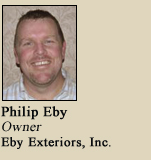 There
are many ways to dress up the exterior of your home without
spending a lot of money! I routinely notice homes that with
a few inexpensive exterior changes could easily go from ordinary
to eye-catching. Beyond the personal enjoyment of feeling
good about how your house looks, improving your home's appearance
will most likely increase its value. The added curb appeal
could more than pay for the cost of the improvement. With
that in mind, I'd like to share a few of the more popular,
low-cost ideas that we use to create better-looking homes
all over central PA. There
are many ways to dress up the exterior of your home without
spending a lot of money! I routinely notice homes that with
a few inexpensive exterior changes could easily go from ordinary
to eye-catching. Beyond the personal enjoyment of feeling
good about how your house looks, improving your home's appearance
will most likely increase its value. The added curb appeal
could more than pay for the cost of the improvement. With
that in mind, I'd like to share a few of the more popular,
low-cost ideas that we use to create better-looking homes
all over central PA.Replace a Bay/Bow Window. Old, worn out bay/bow windows can greatly detract from your home's overall appearance because they are usually a large part of the facade. They also tend to "date" a house. Aesthetics aside, you're probably losing a substantial amount of energy through that old glass as well! Today's bay/bow windows come with a tremendous amount of interior and exterior options including multiple colors, pre finished wood or laminate interiors, Corian seats, decorative art glass, etc. Also, a new bay/bow window provides a great opportunity for our next idea... Add Specialty Roofing. Small sections like a bay/bow window, a porch roof, or a "pent" roof provide an ideal location for a specialty roofing product. Standing-seam copper or steel, synthetic slate shingles, or designer luxury shingles in a variety of colors can provide a beautiful accent to the front of your home. Add Specialty Siding. A front porch and reverse gable in the front of your home are great places to add a specialty siding like cedar shakes, scalloped shakes, or board and batten siding. The definition and character that specialty siding provides will add a huge "wow" factor to your home's appearance. Replace your Front Door and/or Storm Door. For most homes, the front door is the focal point of the house! New doors are surprisingly inexpensive and they can dramatically improve the aesthetics of your home! The styles and options are almost limitless. Also, many homes have an attractive front door that is covered up by an old, unattractive storm door. Adding a new "full-view" storm door in a color that matches or enhances your entry door can do wonders for your home's appearance. Again, for both of these options, you will most likely increase your energy efficiency as well. Add or Replace Shutters. Shutters are a great way to add color and definition to a home. They are easily installed and come in a wide variety of refinished colors that will never need to be painted. Styles include louvered, raised-panel, board and batten and more. Arched or elliptical tops can be added to match similar windows. Decorative pieces such as "S" hooks and hinges can also be added to enhance an authentic, traditional look. Add Window and Door Headers and Surrounds. Headers and surrounds can take an ordinary-looking window or door and give it character and class. These options are available in a large selection of pre-finished colors and styles. Surround profiles can be subtle with a basic flat option or molded profiles and keystones can be used to add more flair. Overhead garage doors, which often dominate the front of a home, can be greatly enhanced with the addition of a surround system such as a wide header with a keystone and fluted pilasters along the sides. These are just a few of the possibilities that can be employed to increase your home's curb appeal without spending a lot of money. Most of them can also be done with minimal intrusion into your home and your lifestyle. At Eby Exteriors, Inc., we gain a lot of satisfaction from improving the appearance of the homes we are privileged to work on! We'd love the opportunity to meet with you and share some ideas as to how we can take YOUR HOME from ordinary to EXTRAORDINARY. (717) 733-9142 ebyexteriors.com Route 272, Akron. With
spring quickly approaching, we are considering a landscape
master plan and potential improvements to our outdoor living
spaces. We realize we need to hire a professional, but we don't
understand the process or what type of help we should be looking
for — can you give us guidance on this?
Answer provided by: Howard Supnik, Owner, Howard Jay Supnik Landscape Architect, LLC  Here
are some questions and answers that will help you gain a
better understanding of landscape design and construction. Here
are some questions and answers that will help you gain a
better understanding of landscape design and construction.What is the difference between landscape architect, landscape designer and landscape contractor? Most states require a landscape architect to pass a rigorous licensing exam and be registered with their state's Board of Landscape Architects. They have either (or both) an undergraduate or graduate degree in landscape architecture and have apprenticed with a licensed professional. Those who have not taken and passed the licensure examination may not use the title "landscape architect." A landscape designer, as opposed to a landscape architect, does not have any requirements — anyone can call themselves a landscape designer. That is not to say there are not talented and professional landscape designers. A landscape contractor is someone who installs the landscape based on plans from the landscape architect or designer. Sometimes the word "landscaper" is used for a contractor or someone who maintains the landscape. What types of services can landscape architects offer? This is a diverse and often misunderstood profession. Services range from concept sketches and hourly consults to master plans, construction drawings, bidding, tree tagging and supervision. Landscape architects help design all aspects of the built environment and are concerned with aesthetics as well as function — they lay out roads, buildings and parking lots, sidewalks, steps, water elements, planting and site furniture including lighting. Some landscape architects are involved solely in site engineering like storm water management. Why is a Master Plan so important? It is the 'big picture', a 'roadmap', and will save you heartache and money in the long run. No matter what size your property is, starting with a plan — a visual, two-dimensional long-term strategy for getting from point A to point B — is essential. It need not be detailed... it doesn't necessarily need specific plantings, materials or construction methods, but it should show areas and relationships, for example house to street, driveway to path, patio to lawn, and planting areas that define outdoor spaces. Because most people do not implement the entire plan all at once, the details are figured out later, when a particular phase of the plan is ready to be started. Master plans should be done in combination with sectional drawings or photographs. This helps in understanding the third dimension and allows the mind to better grasp what views may need to be screened, enhanced or framed, as well as more complicated grading issues signaling the need for retaining walls and steps. Some homeowners may be able to do this on their own, but often require assistance from a landscape architect, who can think more artistically and pull all the programmatic elements together — sometimes just having an objective, independent party will bring some unique and inventive ideas to the table. What will a Master Plan cost? The answer will depend on several things: the size of the property and time it will take for design and presentation, the involvement of the client and number of meetings required, and the ability of the client to visualize in plan view or their need for sketches and imagery to assist them. Some presentation techniques are quicker than others and may not need to be rendered in color, so that can reduce the time and ultimate cost of the plan. After the initial consultation and a better sense of what is required, a fee proposal can be developed. What season is the best time to begin the planning process? The myth is that I am less busy during the winter months. Often I will begin in the late fall for a project hoping to be installed in the spring. Projects requiring Township approvals can take even longer, so it's best not to wait! Hopefully this information is useful and puts you in a better position to proceed with your upcoming project. For more information, I encourage you to visit my web site at www.howardjaysupnik. com, or better yet, give me a call at 519.1554. What
are some of the benefits of stamped concrete and a few questions
to ask your concrete contractor before you choose who you want
to install your stamped patio?
Answer provided by: Bryan Hahn, Owner/President, Stampcrete of Lancaster, Ltd.
How
can ordinary table salt give your pool the same sanitization
performance as chlorine, while eliminating odor, stinging eyes,
irritated skin, and bleached-out swimsuits?
Answer provided by: Craig Horning, Owner, Integrity Pools & Arctic Spas  Good
old fashion ordinary table salt along with the new IntelliChlor
Chlorine Generator is really all you need to maintain clear
water both safely and effectively. Simply add salt to your
pool water and let IntelliChlor work its magic. As the dissolved
salt flows through the IntelliChlor generator cell it is
converted to pure chlorine and is distributed throughout
your pool. This process keeps your water fresh, clear, and
safe. Unlike most conventional chlorine additives IntelliChlor
continuously recycles the salt day after day. Good
old fashion ordinary table salt along with the new IntelliChlor
Chlorine Generator is really all you need to maintain clear
water both safely and effectively. Simply add salt to your
pool water and let IntelliChlor work its magic. As the dissolved
salt flows through the IntelliChlor generator cell it is
converted to pure chlorine and is distributed throughout
your pool. This process keeps your water fresh, clear, and
safe. Unlike most conventional chlorine additives IntelliChlor
continuously recycles the salt day after day.In addition to sparkling, clear water IntelliChlor makes monitoring chlorine as simple as can be with its built-in control and display panel. Just push a button to choose one of the five sanitization levels and IntelliChlor tells you exactly how to set it for proper chlorine output. IntelliChlor also provides you the same sanitization performance as chlorine, without disadvantages like odor, stinging eyes, irritated skin, or bleached-out swimsuits. IntelliChlor is not only simple, safe, and automatic, but a provider for perfect water and a worry-free environment. IntelliChlor can be used on pools up to 40,000 gallons with proper TDS. The cost of this stress-free device ranges roughly from $2,000 to $2,500 in cost. The payback is around 4 years. If an IntelliChlor Chlorine Generator interests you feel free to contact Integrity Pools and Arctic Spas at (717) 393-1600 or stop on by at 2106 Spring Valley Road Lancaster PA. My
husband and I thoroughly enjoy soaking in hot tubs and do so
at every opportunity while visiting resorts. Although we would
love to have one of our own, we’ve heard that they are
a maintenance nightmare. Is spa maintenance really as time
consuming and dreadful as we hear?
Answer provided by: Mike Mclure, Customer Care Coordinator, Oasis Hot Tubs 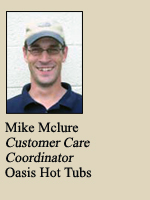 In
the early days (which really weren't that long ago), you
would’ve been right about your maintenance concerns.
Fortunately, the spa technology and additives have evolved
to such a degree that I’m happy to report that nothing
could be further from the truth. Hot tubs today require very
little time and, for that matter, very little money to maintain.
Today's spas are equipped with superior sanitation systems
that allow the user to be confident every time they enter
their spa. In
the early days (which really weren't that long ago), you
would’ve been right about your maintenance concerns.
Fortunately, the spa technology and additives have evolved
to such a degree that I’m happy to report that nothing
could be further from the truth. Hot tubs today require very
little time and, for that matter, very little money to maintain.
Today's spas are equipped with superior sanitation systems
that allow the user to be confident every time they enter
their spa.Among the sanitation system components that are used today are ozanators, which are highly effective bacteria killers. Ozanators produce ozone which produces oxygen 3 which kills bacteria. Unfortunately, ozanators alone will not completely sanitize your spa—assistance is needed from chlorine. Some manufacturers use a combination of sanitizing agents, which include the afore’ mentioned ozanator coupled with a product called Microban. Microban antimicrobial protection was developed to neutralize bacteria and fungal growth in products. Interestingly enough the product never wears out. Microban is used widely in the Johnson and Johnson company, Playskool, Farberware, Fruit of the Loom, just to name a few. Again when using with spas it would be aided by chlorine. The next line of bacteria fighters is the system commonly referred to as mineral cartridges or mineral filters. These are 2 metals combined to be toxic to micro organisms (but NOT humans). This is a highly effective method of sanitation when combined with ozone, Microban and trace amounts of chlorine. The very last item in the maintenance section would be what is called a 24-hour circulation pump. This is simply a pump that runs very efficiently and filters the entire body of water well over 100 times a day, every day. Now, back to your original question. In total, the amount of time you’ll need to commit to spa maintenance is somewhere between a measly 5 to 10 minutes a week. Clearly the maintenance myth is just that—a myth. Happy spa shopping! It
seems that if I put down enough mulch, I don't need to weed,
is it possible to put down too much mulch?
Answer provided by: James T. Hanselman, Owner, Hanselman Landscape
In
landscaping, what is meant by the term a design build company?
Answer provided by: Terry Esbenshade, General Manager, Esbenshade's Landscaping
|
||
© R&A Magazine All rights reserved |

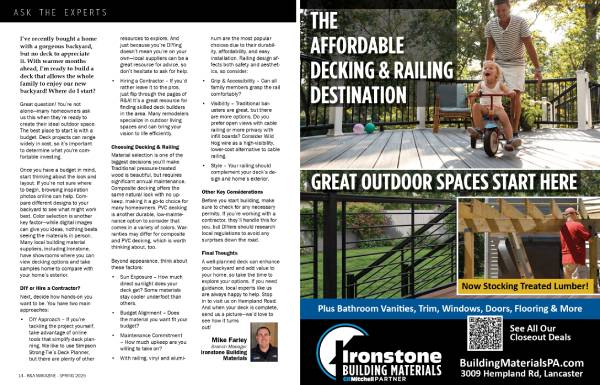

 I agree, a garage expansion probably wouldn’t help—not for long any way. Chances are, additional garage space would be quickly consumed by even more “stuff.” A promising and less expensive solution would be a storage structure for your outdoor and lawn equipment. My suggestion would be to keep the garage for the cars (both of them) and use your added backyard storage shed for everything else.
I agree, a garage expansion probably wouldn’t help—not for long any way. Chances are, additional garage space would be quickly consumed by even more “stuff.” A promising and less expensive solution would be a storage structure for your outdoor and lawn equipment. My suggestion would be to keep the garage for the cars (both of them) and use your added backyard storage shed for everything else. Mmmm....what a mouth-watering question! Let's talk about charcoal grills first.
Mmmm....what a mouth-watering question! Let's talk about charcoal grills first. Almost everything relating to our garden and the garden spaces we create for our clients
has value in the winter view. As shade is reduced from deciduous trees, light reaches
deeper into the garden structure, revealing textures of hill and valley which are muted and
dusky in summer months. Small details are crisper, as light illuminates from a lower angle.
During the cold months of the year, the sky feels closer and especially brilliant in hue when
juxtaposed with a snow-blanketed garden.
Almost everything relating to our garden and the garden spaces we create for our clients
has value in the winter view. As shade is reduced from deciduous trees, light reaches
deeper into the garden structure, revealing textures of hill and valley which are muted and
dusky in summer months. Small details are crisper, as light illuminates from a lower angle.
During the cold months of the year, the sky feels closer and especially brilliant in hue when
juxtaposed with a snow-blanketed garden.  Good question. Patio and deck areas
often receive the full effect of solar
gain especially in the summer sun.
Most often this is so extreme that a
person can’t comfortably walk on the
stones or deck surfaces with bare
feet. The surface seems to multiply
the sun’s energy..
Good question. Patio and deck areas
often receive the full effect of solar
gain especially in the summer sun.
Most often this is so extreme that a
person can’t comfortably walk on the
stones or deck surfaces with bare
feet. The surface seems to multiply
the sun’s energy..  Because James is a gardener, I have been the beneficiary of a garden development project
that has been years in the making and will likely keep us interested and occupied well after
we retire. But it has only been recently, when other once-normal niceties in our livesâfamily
visits, dining out, game nights with friends, travelâhave been taken away, that I am realizing
with profound gratitude all we still have outside our door because we decided to invest in
our garden over the years. Now, more than ever, I appreciate the value of frequent interaction
with natural beauty and the daily refreshment a garden provides. Never before has our
garden been such an escape and source of continual wonder!
Because James is a gardener, I have been the beneficiary of a garden development project
that has been years in the making and will likely keep us interested and occupied well after
we retire. But it has only been recently, when other once-normal niceties in our livesâfamily
visits, dining out, game nights with friends, travelâhave been taken away, that I am realizing
with profound gratitude all we still have outside our door because we decided to invest in
our garden over the years. Now, more than ever, I appreciate the value of frequent interaction
with natural beauty and the daily refreshment a garden provides. Never before has our
garden been such an escape and source of continual wonder!  This question is asked of me probably every yearâstarting as early
as September or the first time the
customer feels a little nip in the air.
I fully understand the concern because every owner wants the best
for their property and their dollar.
Nevertheless, the owners sense of
cold (sometimes starting already at
50 degrees) is different than mine
or, more importantly, the product
that they are asking us to install.
This question is asked of me probably every yearâstarting as early
as September or the first time the
customer feels a little nip in the air.
I fully understand the concern because every owner wants the best
for their property and their dollar.
Nevertheless, the owners sense of
cold (sometimes starting already at
50 degrees) is different than mine
or, more importantly, the product
that they are asking us to install. 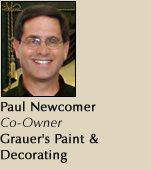 Wood decks are a favorite gathering
place for family and friends year
round. That's why it's very important
that we take the time to protect them
from the elements and ensure that everything is safe and sound. With
just a little bit of planning and routine
maintenance, you'll be able to enjoy
your deck for many long years.
To answer your question thoroughly, I'd
like to address several issues that may
be helpful.
Wood decks are a favorite gathering
place for family and friends year
round. That's why it's very important
that we take the time to protect them
from the elements and ensure that everything is safe and sound. With
just a little bit of planning and routine
maintenance, you'll be able to enjoy
your deck for many long years.
To answer your question thoroughly, I'd
like to address several issues that may
be helpful.